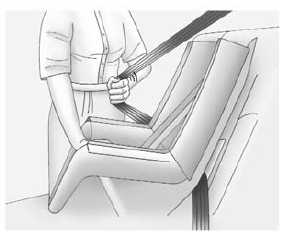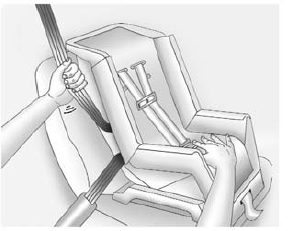Chevrolet Spark Owners Manual: Securing Child Restraints (Front Passenger Seat)
This vehicle has airbags. A rear seat is a safer place to secure a forward-facing child restraint. See Where to Put the Restraint on page 3-38.
In addition, the vehicle has a passenger sensing system which is designed to turn off the front outboard passenger frontal airbag and knee airbag under certain conditions. See Passenger Sensing System on page 3-25 and Passenger Airbag Status Indicator on page 5-11 for more information on this, including important safety information.
Never put a rear-facing child seat in the front. This is because the risk to the rear-facing child is so great, if the airbag deploys.
Warning
A child in a rear-facing child restraint can be seriously injured or killed if the front outboard passenger frontal airbag inflates.
This is because the back of the rear-facing child restraint would be very close to the inflating airbag. A child in a forward-facing child restraint can be seriously injured or killed if the front outboard passenger frontal airbag inflates and the passenger seat is in a forward position.
Even if the passenger sensing system has turned off the front outboard passenger airbag(s), no system is fail-safe. No one can guarantee that an airbag will not inflate under some unusual circumstance, even though the airbag(s) are off.
Secure rear-facing child restraints in a rear seat, even if the airbag(s) are off. If you secure a forward-facing child restraint in the front outboard passenger seat, always move the seat as far back as it will go. It is better to secure the child restraint in a rear seat.
See Passenger Sensing System on page 3-25 for additional information.
If the child restraint uses a top tether, see Lower Anchors and Tethers for Children (LATCH System) on page 3-40 for top tether anchor locations.
Do not secure a child seat in a position without a top tether anchor if a national or local law requires that the top tether be anchored, or if the instructions that come with the child restraint say that the top strap must be anchored.
In Canada, the law requires that forward-facing child restraints have a top tether, and that the tether be attached.
When using the lap-shoulder belt to secure the child restraint in this position, follow the instructions that came with the child restraint and the following instructions:
- Move the seat as far back as it will go before securing the forward-facing
child restraint.
When the passenger sensing system has turned off the front outboard passenger frontal airbag and knee airbag, the off indicator on the passenger airbag status indicator should light and stay lit when you start the vehicle. See Passenger Airbag Status Indicator on page 5-11.
- Put the child restraint on the seat.
- Pick up the latch plate, and run the lap and shoulder portions of the vehicle's safety belt through or around the restraint. The child restraint instructions will show you how.

- Push the latch plate into the buckle until it clicks.
Position the release button on the buckle so that the safety belt could be quickly unbuckled if necessary.

- Pull the shoulder belt all the way out of the retractor to set the lock. When the retractor lock is set, the belt can be tightened but not pulled out of the retractor.

- To tighten the belt, push down on the child restraint, pull the shoulder
portion of the belt to tighten the lap portion of the belt, and feed the shoulder
belt back into the retractor. When installing a forward-facing child restraint,
it may be helpful to use your knee to push down on the child restraint as you
tighten the belt.
Try to pull the belt out of the retractor to make sure the retractor is locked. If the retractor is not locked, repeat Steps 5 and 6.
- Before placing a child in the child restraint, make sure it is securely held in place. To check, grasp the child restraint at the safety belt path and attempt to move it side to side and back and forth. When the child restraint is properly installed, there should be no more than 2.5 cm (1 in) of movement.
If the airbags are off, the off indicator in the passenger airbag status indicator will come on and stay on when the vehicle is started.
If a child restraint has been installed and the off symbol is not lit, see “If the On Indicator Is Lit for a Child Restraint” under Passenger Sensing System on page 3-25.
To remove the child restraint, unbuckle the vehicle's safety belt and let it go back all the way.
 Securing Child Restraints (Rear Seat)
Securing Child Restraints (Rear Seat)
When securing a child restraint in a rear seating position, study the instructions
that came with the child restraint to make sure it is compatible with this vehicle.
If the child restraint has the ...
 Storage
Storage
...
Other materials:
Cruise Control
If equipped with cruise control, the vehicle can maintain a speed of about 40
km/h (25 mph) or more without keeping your foot on the accelerator. Cruise control
does not work at speeds below 40 km/h (25 mph).
Warning
Cruise control can be dangerous where you cannot drive safely
at a steady s ...
Off-Road Recovery
The vehicle's right wheels can drop off the edge of a road onto the shoulder
while driving. Follow these tips:
Ease off the accelerator and then, if there is nothing in the way, steer
the vehicle so that it straddles the edge of the pavement.
Turn the steering wheel about one-eigh ...
Automatic Transmission Shift Lock Control Function Check
Warning
When you are doing this inspection, the vehicle could move suddenly.
If the vehicle moves, you or others could be injured.
Before starting this check, be sure there is enough room around the vehicle.
It should be parked on a level surface.
Apply the parking brake. Be ready to app ...
